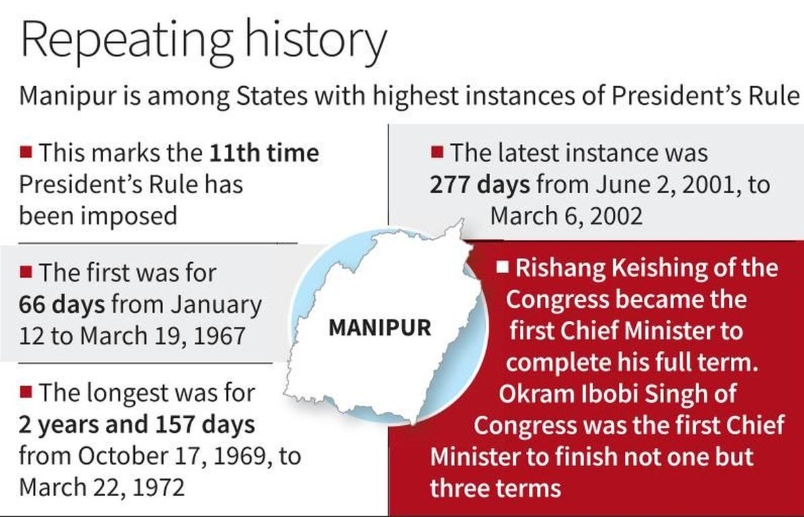How does a President’s rule function?
(Source – The Hindu, International Edition – Page No. – 10)
|
Topic: GS2 – Indian Polity |
|
Context |
|
|
Constitutional Basis for President’s Rule |
|

Process of Imposing President’s Rule
-
Article 356 allows the President to take over the State’s executive functions if the government fails constitutionally.
-
The President acts based on a report from the Governor or other sources.
-
Once imposed, the State government loses executive power, and the legislature is suspended.
-
Parliament assumes the power to legislate for the State.
Approval and Duration of President’s Rule
-
The proclamation must be approved by both Houses of Parliament within two months.
-
If approved, it lasts six months but can be extended in six-month intervals.
-
Extensions beyond one year require:
-
A National Emergency in the country or part of the State.
-
The Election Commission’s certification that elections cannot be held.
-
-
President’s Rule cannot last more than three years.
Difference Between National Emergency and President’s Rule
|
Aspect |
National Emergency (Article 352) |
President’s Rule (Article 356) |
|
Imposition Reason |
Security threats like war or armed rebellion |
State government failure to function constitutionally |
|
Duration |
Can last indefinitely with parliamentary approval |
Requires simple majority for extension, cannot exceed 3 years |
|
Parliamentary Approval |
Needs a special majority |
Requires a simple majority |
|
State Government Function |
State governments continue to function |
State executive is dismissed |
|
Assembly Status |
Assembly remains functional |
Assembly may be placed under suspended animation |
|
Revival of Assembly |
No provision for revival |
Assembly can be revived if political stability is restored |
Impact on Fundamental Rights
-
President’s Rule does not suspend fundamental rights.
-
During a National Emergency, Article 19 (freedom of speech and expression) is suspended.
-
Under President’s Rule, the President controls the State through the Governor and advisers.
-
The President can authorize State expenditure under Article 357.
Frequency of President’s Rule in India
-
President’s Rule has been imposed 134 times in different States and Union Territories since 1950.
-
The first instance was in Punjab in June 1951.
-
Manipur has experienced it 11 times, making it one of the most affected States.
-
The longest President’s Rule in Manipur lasted over two years and 157 days (1969–1972).
-
Jammu & Kashmir has had the longest cumulative President’s Rule, lasting over 12 years (4,668 days) due to security concerns.
Judicial Review and Limitations on President’s Rule
-
Initially, courts upheld frequent use of President’s Rule.
-
In 1994, the Supreme Court redefined its scope in a landmark case.
-
The Court ruled that:
-
Article 356 should be used only as a last resort.
-
The Centre must issue a warning before dismissing a State government.
-
President’s Rule is subject to judicial review and can be struck down if misused.
-
Parliament’s approval is needed before dissolving a State Assembly.
-
It must be invoked only for a breakdown of constitutional machinery, not for political reasons.
-
Conclusion
-
President’s Rule is a constitutional provision meant for crises but has been frequently used.
-
Judicial rulings now ensure stricter checks to prevent misuse.
-
Manipur’s case highlights ongoing instability and the need for political resolution.
|
Practice Question: Discuss the differences between National Emergency and President’s Rule in India, with reference to their imposition, duration, and impact on state governance. (250 Words /15 marks) |

